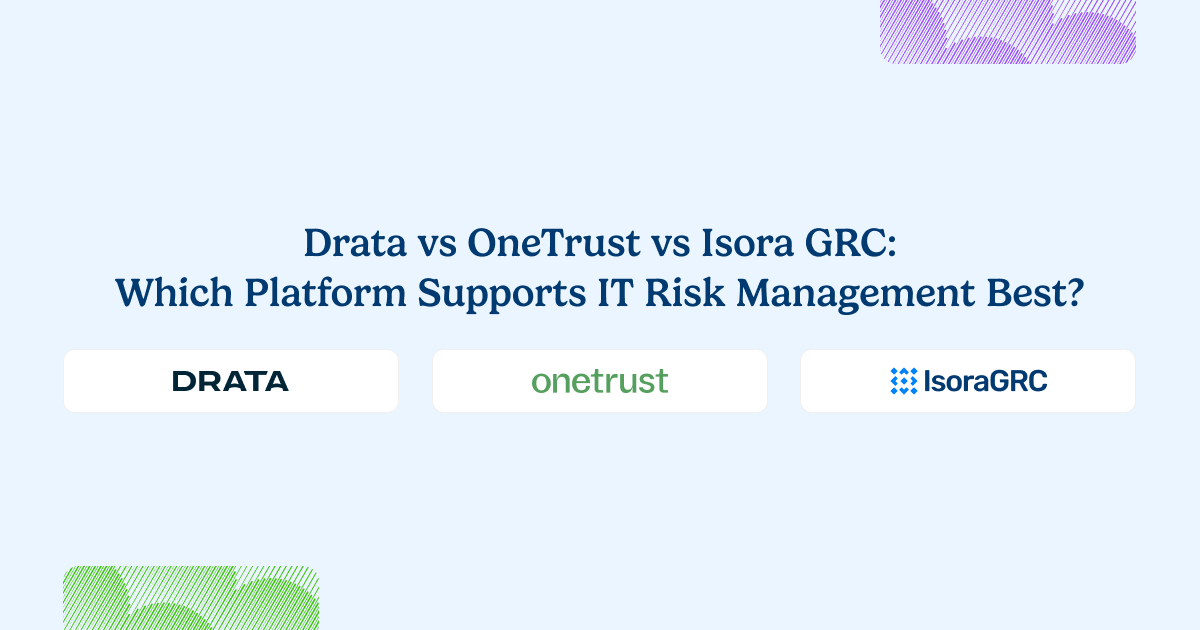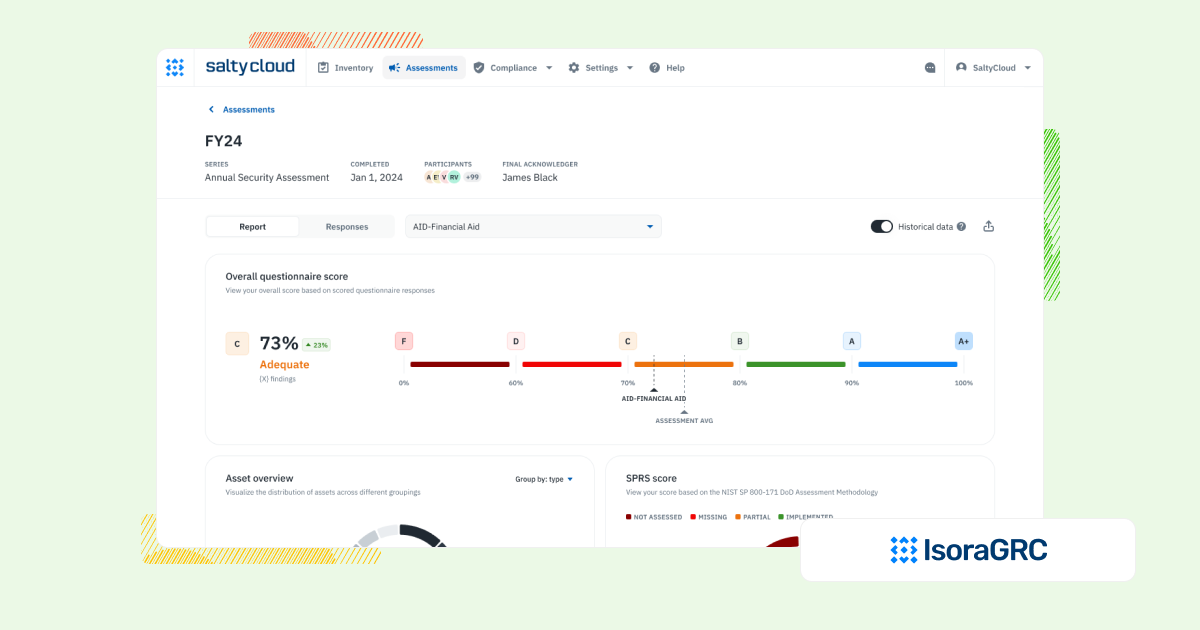
Every security team needs a reliable, scalable way to manage IT risk—beyond just passing audits.
Tools like Drata and OneTrust reflect two ends of the GRC spectrum: compliance automation and enterprise-wide coverage.
These tools automate audit prep, but don’t support the deeper workflows required for ongoing IT risk management. And when a platform tries to do everything, it often sacrifices usability and speed—leaving security teams with more complexity than clarity.
Isora GRC takes a more streamlined path. It’s purpose-built for security teams who need to run assessments, manage inventories, and track risks—without relying on generic checklists or sprawling GRC infrastructure.
Here’s a closer review.
Choosing the Right Platform for IT Risk Management
Drata and OneTrust shine when it comes to automating audit evidence collection—but their workflows are often rigid and narrowly focused on certification processes. They aren’t designed to support the full lifecycle of risk management across an evolving organization.
Isora GRC is different. It delivers structured, repeatable workflows for internal and external risk assessments, inventory management, exception tracking, and collaborative risk registers—making it easier for security teams to operationalize continuous risk management, not just prepare for audits.
The Workflow That Matters: Managing IT Risks and Compliance
Managing IT risk is an ongoing, collaborative effort—not a one-and-done audit. Security teams need to continuously assess internal units and vendors, maintain inventories, track emerging risks, and manage exceptions as part of their everyday workflow.
Audit-focused platforms often stop at compliance preparation, leaving teams without the flexibility or depth needed for continuous risk monitoring and engagement across the organization.
Isora GRC bridges that gap—helping security teams manage the full risk lifecycle with structured workflows that drive better visibility, faster collaboration, and stronger risk outcomes.
How Each Platform Supports IT Risk Management Workflows
| Workflow Area | Drata | OneTrust | Isora GRC |
| Assessment Management | Drata supports continuous compliance with automated assessments. Some users say the system feels too strict. Customization is limited, which may cause problems for companies with complex needs. | OneTrust helps with assessments, but users often face trouble with workflows. Many steps stay manual, slowing down teams. Custom options feel limited, so changing forms for your needs gets tricky. | Centralized, intuitive assessment dashboard across business units, vendors, and assets. Built specifically for security teams. |
| Questionnaire Delivery & Completion | Drata includes vendor questionnaires. However, some users want more advanced features. Dynamic workflows, for example, could make assessments more interactive. | Surveys work in OneTrust, but the layout feels complex. Staff may need time to learn the system. Custom tools for forms don’t match what some other platforms give, so flexibility stays low. | Customizable and prebuilt questionnaires for frameworks like NIST, ISO, GLBA, HIPAA, and more. Designed for internal and external collaboration. |
| Inventory Tracking | Drata focuses on compliance, not asset tracking. Companies with lots of assets may need deeper tracking tools. | Inventory tools feel basic. Teams with many assets may not get enough depth. The risk log also needs work, and links to other tools stay weak. | Centralized tracking of assets, vendors, and organizational units with integration support for existing data sources. |
| Risk Register & Exception Management | Risk tools exist in Drata, but many users find them too basic. Larger teams may need stronger options for risk and exception handling. | The risk log works but may not fit every workflow. Some teams must add code or extra steps to adjust it. Handling exceptions takes effort and may pull in more staff time. | Flexible, collaborative risk register with scoring, status, evidence, and ownership tied directly to assessments. Exception management is built-in and intuitive—no extra modules or configuration required. |
| Scoring, Reporting & Risk Visualization | Drata creates automated reports and dashboards. Some users say the reports lack detail and flexibility. Risk visuals feel limited for those needing deeper insights. | OneTrust gives charts and reports, but many users find the layout confusing. Learning the system takes time. Reports feel harder to use than some others, which may slow down analysis. | Automated scorecards, risk maps, and executive-friendly reports with actionable insights—no manual config required. |
| Collaboration & User Experience | Drata has a clean and simple interface. Still, collaboration tools feel shallow. Big teams may struggle with cross-department workflows. | Using OneTrust can feel tough without tech skills. The layout may turn off new users. On the plus side, free online training and badges can help staff learn faster. | WCAG-compliant, award-nominated interface with built-in commenting, team workflows, and fast onboarding. |
| Implementation & Setup | Setup looks simple at first. But some teams report long onboarding times. Complex setups often need expert help, which may be tough for smaller companies. | Getting OneTrust up and running takes time. Setup and moving data need strong teams and resources. Small teams may struggle due to cost and effort. The price can also block smaller businesses. | No-code setup in days or weeks. Minimal IT lift required. Designed to go live quickly across teams and vendors. |
What Sets Isora GRC Apart?

Isora GRC was purpose-built for information security teams—designed to support the real workflows behind risk and compliance, not just generate reports. While legacy GRC platforms require months of configuration and rigid processes, Isora takes a modern, scalable approach:
- Purpose-built for security and third-party risk teams
- No extra modules or cross-department bloat—just the workflows that matter.
- Easy for anyone to use
- Clean UI, no complex training, and built to drive adoption across the org.
- Streamlined for action, not just documentation
- Assessments, questionnaires, inventories, risk tracking, and reporting—all in one place.
- Fast, no-code implementation
- Go live in weeks, not quarters, with minimal IT lift.
- Scales with your program
- Whether you’re running a lean risk function or supporting a large institution, Isora grows with you—without getting in the way.
Who Each Platform Is Best For
| Platform | Who It’s For |
| Drata | Startups rushing to get SOC 2 done. Quick wins, but not built for full-risk programs. |
| OneTrust | Teams focused on privacy, third-party checks, and sustainability. Works fast but leans more toward general compliance than InfoSec. |
| Isora GRC | Security teams that need a scalable, usable IT risk management program across their organization. |
What Our Customers Say About Isora GRC
Security teams at top institutions are using Isora GRC to replace legacy tools and manual processes with intuitive workflows and actionable insight.
“Moving from manual processes to using Isora was a breath of fresh air. What used to take months is now automated, reliable, and defensible. Isora saves us significant time while delivering accurate insights that improve decision-making.”
Jessica Sandy, IT GRC Manager, The University of Chicago
“Isora has been essential in helping us meet our University of California cybersecurity requirements across a decentralized campus. Automating assessment data collection and reporting has given us clear visibility into unit-level risks, enabling us to prioritize resources effectively and address gaps with confidence.”
Allison Henry, CISO, The University of California, Berkeley
FAQs
What’s the difference between Drata, OneTrust, and Isora GRC?
Drata focuses on automating audit preparation for frameworks like SOC 2 and ISO 27001. OneTrust is a broader privacy and compliance platform with GRC features. Isora GRC is built for security teams managing IT and vendor risk as ongoing workflows—not just audits.
Are Drata and OneTrust considered GRC platforms?
OneTrust is an all-in-one GRC platform with a strong focus on privacy and third-party risk. Drata is more narrowly focused on compliance automation. Both can support parts of the GRC picture, but neither is built specifically for managing assessments, inventories, and risk over time.
Does Isora GRC replace tools like Drata or OneTrust?
For teams focused on IT and third-party risk management, yes. Isora GRC supports broader workflows like internal and vendor assessments, exception tracking, and collaborative risk registers—without limiting teams to audit timelines or privacy modules.
Which platform is better for managing IT risk across the organization?
Isora GRC is designed for that exact use case. It supports structured, repeatable workflows across internal teams and third parties, with tools built for adoption and scale. Drata is better suited for audit automation; OneTrust is often used for privacy and legal compliance.
Can Isora GRC be used alongside Drata or OneTrust?
Yes. Some organizations use Drata for audit prep and Isora for broader risk management. Others rely on OneTrust for privacy or vendor tracking while using Isora for operational security workflows.
What should I look for in a GRC platform to support security teams?
Prioritize platforms that support assessments, inventories, exception management, and risk tracking. Isora GRC delivers all of this in a focused platform that security teams can deploy and use—without deep configuration or dependency on audit timelines.



















 Other Relevant Content
Other Relevant Content